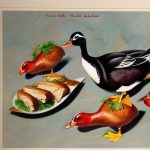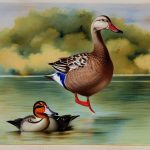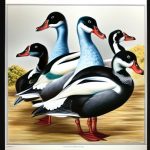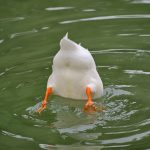Blue Swedish ducks are a beautiful and unique breed of domestic duck known for their striking blue plumage and friendly disposition. They are a medium-sized breed, with a calm and gentle nature, making them an excellent choice for both backyard hobbyists and commercial duck farmers. Blue Swedish ducks are not only prized for their attractive appearance but also for their versatility and usefulness. They are known for their excellent egg-laying abilities, as well as their delicious and flavorful meat. In addition, they are often kept for their pest control abilities, as they are natural foragers and enjoy eating insects and other pests. Overall, Blue Swedish ducks are a popular choice for those looking to raise ducks for eggs, meat, or simply as charming and low-maintenance pets.
Table of Contents
- 1 Physical Characteristics of Blue Swedish Ducks
- 2 History and Origin of Blue Swedish Ducks
- 3 Behavior and Temperament of Blue Swedish Ducks
- 4 Care and Maintenance of Blue Swedish Ducks
- 5 Uses and Benefits of Blue Swedish Ducks
- 6 Conclusion and Considerations for Raising Blue Swedish Ducks
- 7 FAQs
- 7.1 What are the characteristics of Blue Swedish duck breeds?
- 7.2 What is the average lifespan of Blue Swedish ducks?
- 7.3 What is the purpose of raising Blue Swedish ducks?
- 7.4 What are the ideal living conditions for Blue Swedish ducks?
- 7.5 Are Blue Swedish ducks good for beginners in duck farming?
Key Takeaways
- Blue Swedish Ducks are a popular breed known for their striking blue plumage and friendly temperament.
- These ducks are medium-sized with a broad, deep body and a unique blue coloration with white markings.
- Blue Swedish Ducks originated in Sweden and were first recognized as a breed in the 19th century.
- They are known for being calm, friendly, and good foragers, making them a great choice for backyard or small farm settings.
- Proper care and maintenance of Blue Swedish Ducks includes providing a suitable living environment, balanced diet, and regular health checks.
Physical Characteristics of Blue Swedish Ducks
Blue Swedish ducks are easily recognizable by their striking blue plumage, which is a result of a genetic mutation that causes the black coloration in their feathers to appear as a deep shade of blue. Their bodies are medium-sized, with a broad and rounded shape, and they have a slightly upright stance. Their bills are a dark slate color, and their legs and feet are a deep orange. The males, known as drakes, have a slightly more pronounced curl to their tail feathers, while the females, known as ducks, have a more subtle and rounded tail. Both males and females have a white bib on their chest, which contrasts beautifully with their blue feathers. Overall, Blue Swedish ducks are a visually stunning breed that is sure to stand out in any flock.
In addition to their striking appearance, Blue Swedish ducks are also known for their hardiness and adaptability. They are able to thrive in a variety of climates and are well-suited to both free-range and confined living situations. Their calm and friendly nature makes them easy to handle and work with, making them an excellent choice for those new to raising ducks. Whether kept for eggs, meat, or simply as charming additions to a backyard flock, Blue Swedish ducks are sure to make a delightful and valuable addition to any farm or homestead.
History and Origin of Blue Swedish Ducks
The exact origins of the Blue Swedish duck breed are not well-documented, but it is believed that they originated in Sweden in the 19th century. They are thought to be the result of crossbreeding between local Swedish ducks and other European duck breeds, resulting in the unique blue coloration that sets them apart from other domestic duck breeds. Blue Swedish ducks were first imported to the United States in the late 19th century and quickly gained popularity for their attractive appearance and practical uses.
Over the years, Blue Swedish ducks have become a beloved breed among duck enthusiasts and small-scale farmers alike. Their striking blue plumage and friendly disposition have made them a favorite choice for those looking to raise ducks for eggs, meat, or simply as charming additions to their backyard flocks. Today, Blue Swedish ducks can be found in many parts of the world, where they continue to be valued for their beauty, versatility, and usefulness.
Behavior and Temperament of Blue Swedish Ducks
Blue Swedish ducks are known for their calm and friendly nature, making them an excellent choice for those looking to raise ducks as pets or for small-scale farming purposes. They are generally docile and easy to handle, making them suitable for families with children or those new to raising ducks. Blue Swedish ducks are also known for their sociable behavior and often enjoy the company of other ducks or poultry. They are not particularly noisy birds and are generally content to spend their days foraging, swimming, and relaxing in the sun.
In addition to their friendly disposition, Blue Swedish ducks are also known for their natural foraging abilities. They enjoy eating insects, slugs, and other pests, making them an excellent choice for those looking to keep their gardens or yards free of unwanted critters. Their adaptability and hardiness make them well-suited to a variety of living situations, whether free-ranging on a farm or living in a confined space in a backyard coop. Overall, Blue Swedish ducks are charming and low-maintenance birds that are sure to bring joy and utility to any farm or homestead.
Care and Maintenance of Blue Swedish Ducks
Caring for Blue Swedish ducks is relatively straightforward and requires minimal effort compared to other livestock animals. Providing them with access to clean water for swimming and drinking is essential for their health and well-being. They also require access to a balanced diet that includes a mix of commercial duck feed, fresh greens, and occasional treats such as mealworms or cracked corn. It is important to provide them with adequate shelter from predators and the elements, as well as regular access to clean bedding material.
In terms of health care, Blue Swedish ducks require regular monitoring for signs of illness or injury. They should be provided with regular access to veterinary care to ensure that they remain healthy and free from disease. Additionally, regular grooming and maintenance of their living quarters is essential for keeping them clean and comfortable. Overall, caring for Blue Swedish ducks is relatively simple and can be easily managed by those new to raising ducks or poultry.
Uses and Benefits of Blue Swedish Ducks

Blue Swedish ducks are valued for their versatility and usefulness in a variety of farming and homesteading contexts. They are prized for their excellent egg-laying abilities, with hens typically laying around 150-200 large white eggs per year. These eggs are delicious and nutritious, making them a valuable addition to any kitchen or farm stand. In addition to their eggs, Blue Swedish ducks are also raised for their flavorful meat, which is lean and rich in flavor. Their natural foraging abilities make them an excellent choice for those looking to keep pests under control in their gardens or yards.
Furthermore, Blue Swedish ducks are often kept for their charming and low-maintenance nature, making them an excellent choice for those looking to raise ducks as pets or as part of a diverse backyard flock. Their striking blue plumage makes them stand out among other domestic duck breeds, adding visual interest to any farm or homestead. Overall, Blue Swedish ducks are valued for their beauty, utility, and friendly disposition, making them an excellent choice for those looking to raise ducks for eggs, meat, pest control, or simply as delightful additions to their flocks.
Conclusion and Considerations for Raising Blue Swedish Ducks
In conclusion, Blue Swedish ducks are a unique and valuable breed known for their striking blue plumage, friendly disposition, and practical uses. Whether kept for eggs, meat, pest control, or simply as charming additions to a backyard flock, Blue Swedish ducks are sure to bring joy and utility to any farm or homestead. Their hardiness, adaptability, and low-maintenance nature make them an excellent choice for those new to raising ducks or poultry. With proper care and attention, Blue Swedish ducks can thrive in a variety of living situations and provide valuable resources such as eggs and meat.
When considering raising Blue Swedish ducks, it is important to provide them with access to clean water, a balanced diet, adequate shelter from predators and the elements, regular health care, and grooming. Additionally, it is important to consider the practical uses of Blue Swedish ducks such as egg-laying abilities, meat production, pest control, or simply as charming pets. Overall, Blue Swedish ducks are a delightful and versatile breed that is sure to bring joy and utility to any farm or homestead.
If you’re interested in learning more about raising ducks, you might also want to check out Poultry Wizard’s article on “What Kind of Coop is Best for Chickens.” Understanding the best coop options for chickens can provide valuable insights into creating a suitable environment for your blue Swedish duck breeds. You can find the article here.
FAQs
What are the characteristics of Blue Swedish duck breeds?
Blue Swedish ducks are medium-sized with a blue plumage that has a unique lacing pattern. They have a calm and friendly temperament, making them suitable for backyard or small farm settings.
What is the average lifespan of Blue Swedish ducks?
Blue Swedish ducks have an average lifespan of 7-10 years when properly cared for.
What is the purpose of raising Blue Swedish ducks?
Blue Swedish ducks are primarily raised for their meat and eggs. They are also popular for their ornamental value due to their attractive blue plumage.
What are the ideal living conditions for Blue Swedish ducks?
Blue Swedish ducks thrive in a free-range environment with access to water for swimming and foraging. They also require shelter to protect them from predators and harsh weather conditions.
Are Blue Swedish ducks good for beginners in duck farming?
Yes, Blue Swedish ducks are considered a good choice for beginners in duck farming due to their docile nature and ease of care. They are also known for being good foragers and are relatively low-maintenance.
Meet Walter, the feathered-friend fanatic of Florida! Nestled in the sunshine state, Walter struts through life with his feathered companions, clucking his way to happiness. With a coop that’s fancier than a five-star hotel, he’s the Don Juan of the chicken world. When he’s not teaching his hens to do the cha-cha, you’ll find him in a heated debate with his prized rooster, Sir Clucks-a-Lot. Walter’s poultry passion is no yolk; he’s the sunny-side-up guy you never knew you needed in your flock of friends!







